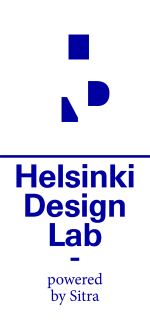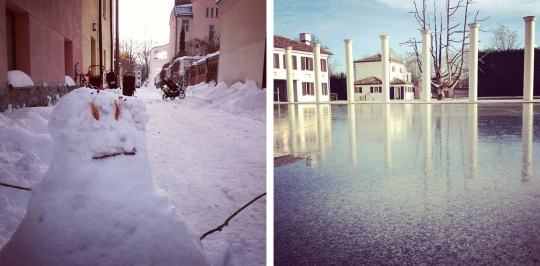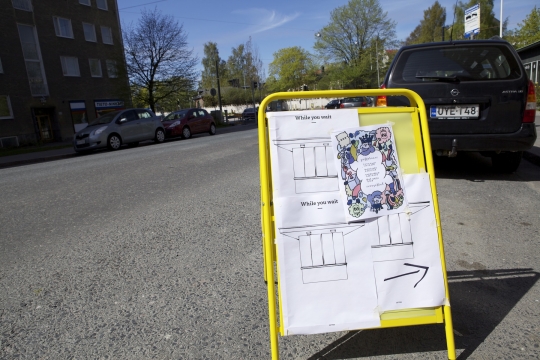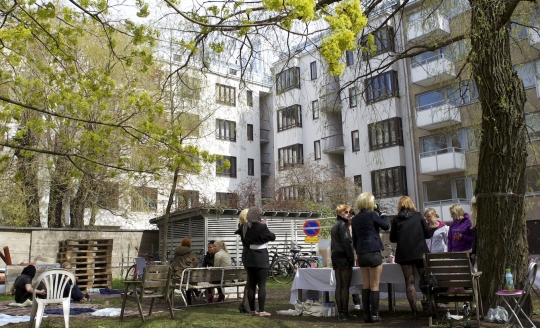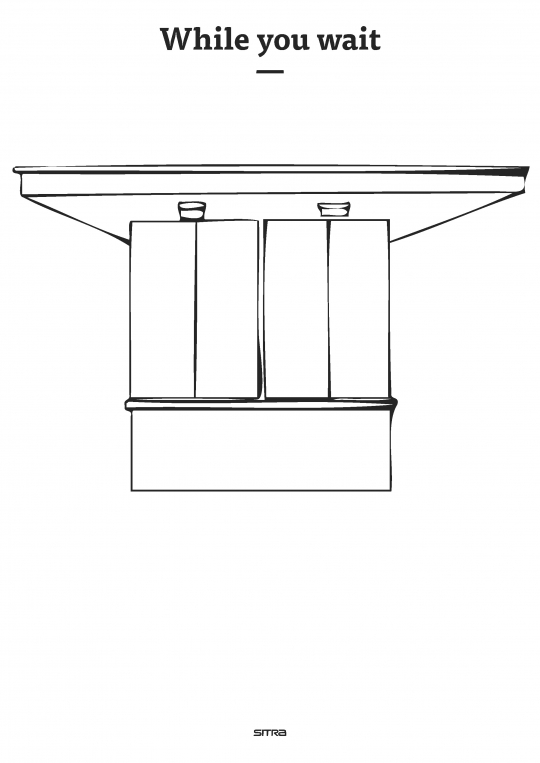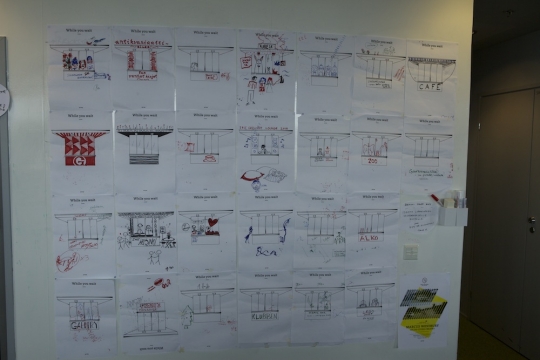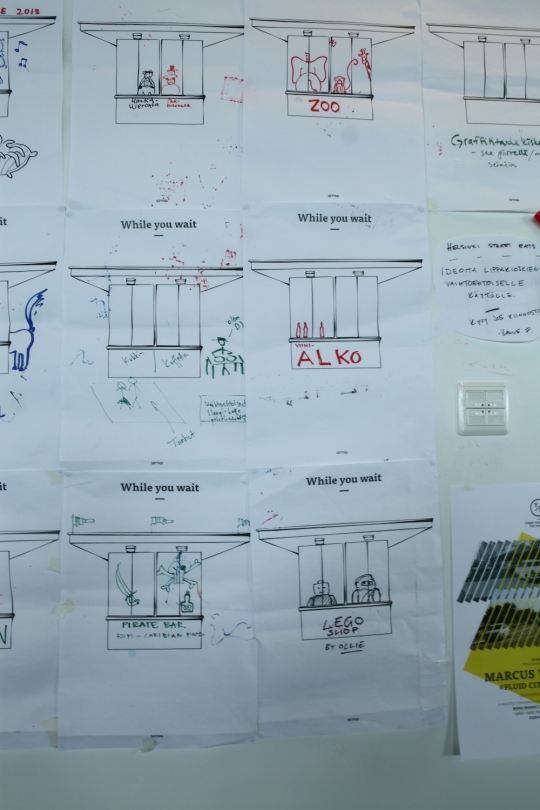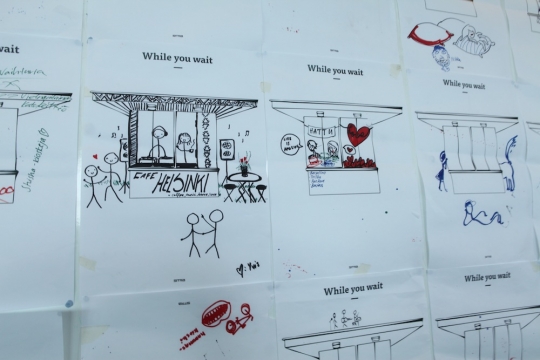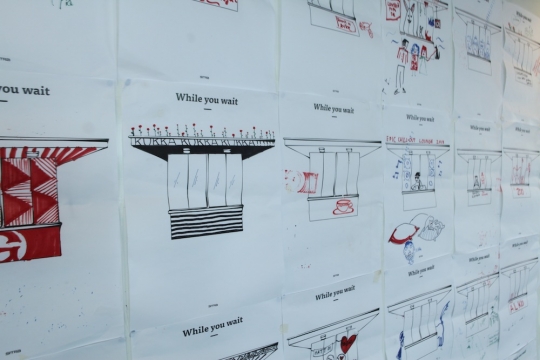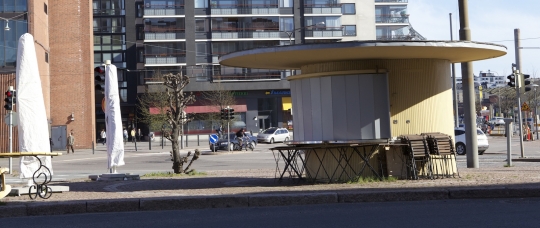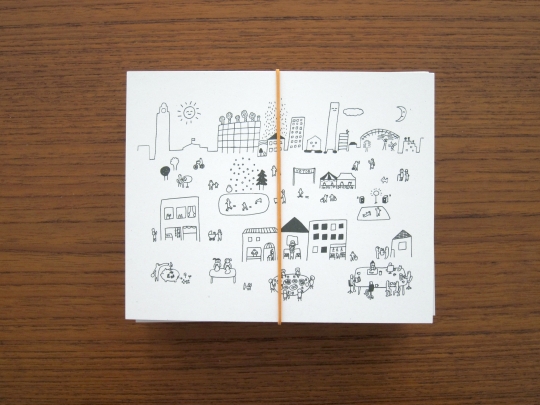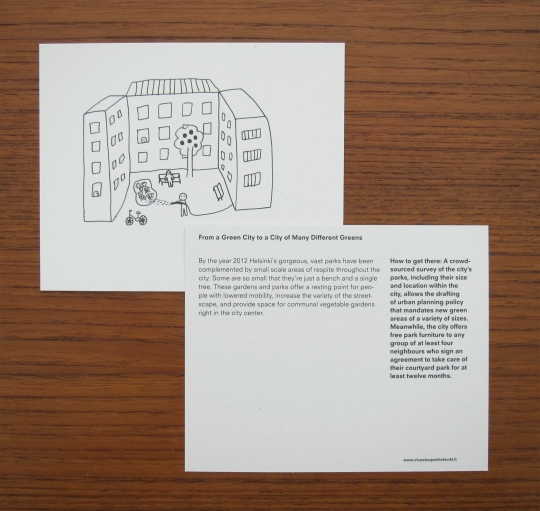Elsewhere at Sitra
As Bryan has already noted, a month ago I left Sitra, left Helsinki and moved to Italy, where I’m the now the CEO of Fabrica, a communications research centre and trandisciplinary studio. (You can read about that here.) Back in Helsinki for the weekend, having left a lush autumnal Veneto on Thursday, I’m posting this from a city that is now −5 and deep under snow.
I leave with mixed feelings: I could not be more excited about the new role at Fabrica, and equally I’m very proud of the projects that we created or developed here—Brickstarter, Open Kitchen, Design Exchange, Low2No and Helsinki Design Lab—and yet, as well as missing Helsinki, I also feel a loss that I’m not able to help take those projects forward.
This last aspect is clearly not important to anyone else, though; what is important are that the projects do have lots of life left within them, numerous unexplored avenues, and that they are taken forward in different contexts, tested under different conditions, by people more than capable of doing so. And that includes you, reader.
For instance, we often get emails asking us if Brickstarter is launching near them; we reply that they can take it! All Brickstarter is, essentially, is a tool to crack open discussions with government, and in public, constructed by taking the existing tropes of social media and crowdfunding and throwing them at spaces, communities and governance. It’s a sketch, and as such can be reinterpreted by others. There is no unique IP there as such—Sitra is a public body—and our “legible practice” approach is intended to enable you to take what we produce and deploy it elsewhere. Equally, there is no particular magic there. Again, it’s taking off-the-shelf cultural artefacts—social media—and deploying them in a slightly different context to their usual mise-en-scene.
The issue is in how you do it, who is doing it. That is what holds governments back usually, as there is barely a government, at city or state level, anywhere in the world who has the right people in the right place. In the particular case of Brickstarter, that means coders, designers, community managers, organisational entrepreneurs in strategic positions at the heart of government. Those things are usually treated as services to be bought in from outside and frankly, by people who don’t know what they’re buying.
However, there are a few honourable exceptions to this emerging, which is very encouraging. Those people have no need of Brickstarter and Open Kitchen, as they will already have a hunch as to what to do and how to do it. That could be you.
We’ve been so open and precise about the development of Brickstarter that it has often confused. Again, it is a sketch, and a conversation. To make that meaningful, we had to detail everything, to think it out loud, as it were. Thus, people thought it was a real live service—some people who can only see things through the lens of “hot new startups” and then wondered as to why we were blogging about other urban crowdfunding services (“Were those not competitors?”)
No, it was research, and designing a real(ish) website was also research, but research that is intended to affect. As we’ve written elsewhere, only by making do you genuinely influence—as it forces you to make meaningful decisions, as well as making abstract concepts tangible and legible —and I hope we made just enough to help bend the debate in a productive direction, just a notch. One of our core points to get across is that the ability to design a convincing looking website relatively rapidly, as well as a clickable prototype front-end, is not confined to Californian start-ups. In fact, it’s perfectly possible to pull it off in a relatively slow-moving, relatively bureaucratic public body in a welfare state. (The UK’s Government Digital Service is doing this for real, of course.)
We often quote Joi Ito, as a) he’s very smart, and b) so damn quotable! But here I might quote his predecessor at MIT, Nicholas Negroponte in Wired UK last month, found in a great piece about Ito.
“Start-ups are perforce small—you’ve got to focus, the blinders get narrower. By definition it’s not big thinking.”
I find that an interesting, subtle critique, and in getting Sitra, an institution—in an age when institutions are permanently under the cosh—to borrow a little from start-up culture without losing its institutional status and capacity, we might actually shoot for an interesting space in the middle, something other than the hegemonic start-up, if I read between Negroponte’s lines. With the ability to move quickly and prototype, yet retaining “big thinking”, systemic change.
Anyway. This approach to legibility—to thinking out loud through communicable means, in public—means that we can at least move on, and the projects live on. Brickstarter, in appearing in Steven Johnson’s latest amongst numerous other places, has already help move the conversation on in practical terms, we think. And I’ll continue the themes we started here in my new role at Fabrica, just as the others will too.
Watch out also for Open Kitchen, which we’ve published less about, mainly due to the fact that this is more of a real partnership. But if Brickstarter is largely applied research and discussion starter, trying to affect a culture, Open Kitchen is real live service deployed into the real live city, also trying to nudge the city's food culture forward. Watching the videos of the applicants to Open Kitchen was actually rather moving—that feeling you get when a hunch becomes a project, and then people adopt that project with gusto, and fill it with their own lives, enthusiasms, energy and spirit.
Open Kitchen is running now, and I’m sure it will be reported on thoroughly here and elsewhere. But that too is a project I’m proud of, which has filled much of the last year. It’s been hugely rewarding to move a project that started as a food truck concept for Low2No, via research, writing, teaching, drawing and self-publishing, into some kind of “HEL YES’s Kitchen”, a food start-up incubator running in the renovated abbatoir in Kalasatama, and subtly aimed at building a new user-centred interface onto the City of Helsinki. Many thanks to Ville Relander from City of Helsinki, Antto Melasniemi and Elina Forss, for this one. It’s been a blast.
The broader strategic design practice will move forward too. When we held HDL 2012 a couple of months ago, we were lucky enough to bring together a group of people to unpack various approaches to strategic design. It was heartening to see the emerging community around this work; although the work is still at the edges, it’s building momentum and a faint network of lines is being traced across the map.
For instance, on hearing my news Justin McGuirk remarked to me that it was a shame he can no longer say, “At least the Finns get it!” (Justin had written about our work a couple of times in The Guardian.) I told him that he still can say that, but also that he can also say the Danes get it (at Mindlab), the Americans get it (via IDEO, Brownsville Partnership, Local Projects and others), the Chileans get it (via Elemental, Tironi et al), the Brits are beginning to get it (at Nesta, Government Digital Services and elsewhere) and the Canadians and the Australians are now getting it too, with similar operations emerging in those very different corners of the globe. We’ve sometimes helped shape them a little, based on our Finnish experience and through hosting the network occasionally, just as others have, but most of this—and in particular the hard graft of getting it done in their particular cultures—is all their own work. That is also heartening.
All these—and more we don’t know about—are deploying design in new ways, in various modes and alongside other approaches, to help shape public decision-making and rethink more resilient public sectors. I think the work we’ve done here has helped push this mission along, and I’m proud of what we got done in my couple of years here, as a small part of the longer project by my colleagues, which still continues.
Huge thanks to the team—Anna, Bryan, Justin and Marco, and our great interns Kalle and Maija—as well as those other teams at Sitra I’ve worked with, and all our external partners—hello Antto, Elina and various Villes!, and the various ministries and government departments on Design Exchange, partners on Low2No—as well as our supporters in Helsinki and elsewhere.
Kiitos, moi moi.
Note: This is cross-posted from Insidejob.fi since it's relevant to readers of the HDL blog too.
Our Design Exchange Programme is growing again. In August we placed Jaana Hyvärinen to work with the City of Helsinki Department of Social Services, where she will focus on integrating service design into the organization’s strategy. While the public sector is improving its service design capability, we also need to build organizations capable of framing relevant questions in the first place. No one wants a fantastically delivered service for something useless, or even harmful. How about the best surgery for those who don’t need it? So this is a wordy way of saying that we see service design as one part of a compliment of approaches to bring coherence to what we say, what we do, and how we do it.

Bryan standing below the Finnish saying “Fear of God is the beginning of wisdom”. DEP is as much about entrepreneurship as it is about culture. Can we build a culture that stems from trust instead of from fear?
Our societies have built great innovation traditions in the private sector, but that entrepreneurship can still be dormant in the public sector. While Helsinki Design Lab is about knowledge creation, capture, and dissemination, DEP was conceived to build capability within the public sector in Finland. Sitra's design-related work balance two sides of the same effort. We reflect on the knowledge and craft of strategic design through HDL, and build practical capabilities through programs like DEP. Public sector entrepreneurship requires both.
We're excited to announce that we now have two more openings for public sector designers, this time working within two Finnish Ministries. One position is open within the Ministry of Employment and the Economy (TEM) and the other within the Ministry of the Environment (YM). Applications for these these one-year positions are closing soon, so take a look at our job posting if you are interested. Please also help us spread the word!
This round of hires will bring our DEP total to four placements. Our gamble was that DEP would be a great learning experience for our embedded designers, for the hosting Public Sector organizations who gain a new capability, and us who get to learn first hand from this experiment. Early indications are positive and we will undoubtedly be examining the questions of whether to build DEP into something beyond this first pilot year.
Another newcomer reporting! My name is Maija and I just joined the Strategic Design Unit as an intern. Originally from Finland, I’m currently enrolled in a Master’s course in Gothenburg, Sweden. I study at the University of Gothenburg in a program called Business & Design. The two-year program is a joint venture between HDK (the School of Design and Crafts) and the School of Economics and focuses on working with design strategically within organisations. After finishing the first year I’m joining Sitra for a semester as a part of my studies.
My background is in the field of culture, literature and the arts and I’ve been working with arts management as well as event production both in non- and for-profit organisations. I’m looking forward to an interesting time here at Sitra; already my first day has been quite a ride!
Aside from work I plan to enjoy the Finnish summer and you’ll most likely find me sailing in the archipelago or enjoying the quietness of our summer house by the sea. I am a Finn, after all.
Ha det bra!
What follows next is a pro barista tip courtesy of Strategic Design Unit. If you want to gather people somewhere, make them stay there longer and boost their creativity - serve them really good, well brewed and freshly roasted coffee.
Last Saturday was the Ravintolapäivä ( "Restaurant Day" ) when anyone "can" set up a pop up restaurant, cafe or a bar just for that one great day. People reclaim the streets and fill them with cheerful chatter, buzz and food. There's a very diverse range of food available from North Korean pork buns to Lady Gaga cupcakes. The fact that this was the 5th Restaurant Day clearly show that there's demand for inexpensive, well-prepared and diverse street food. However, the day after the restaurants and cafes are gone. Cars are back, there's no food, and people have abandoned the streets again.
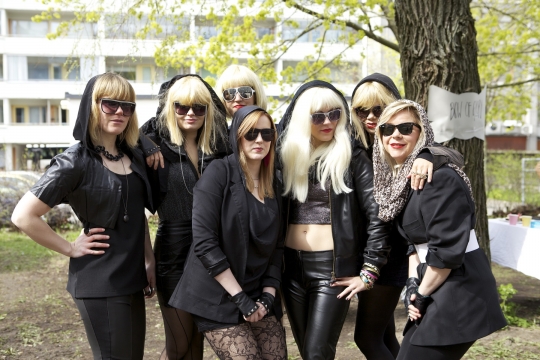
Lady Gagas running a cup cake pop up.
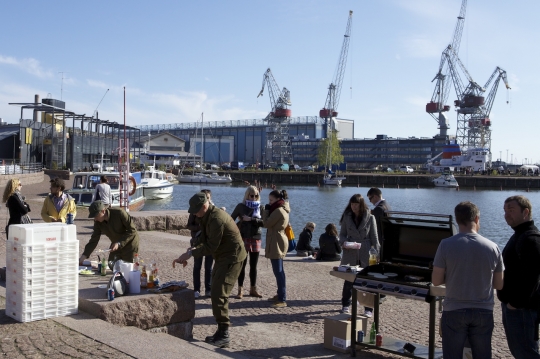
North Korean miso salmon and pork buns by the sea.
This phenomenon sparked the idea for last weekend's "Sitra Coffee Lab" if you like. Besides me serving espresso based drinks we had a hidden agenda. While the customers were waiting for the drinks we asked them to sketch what would they like to see, eat, drink, feel or listen to on the streets of Helsinki in everyday life.
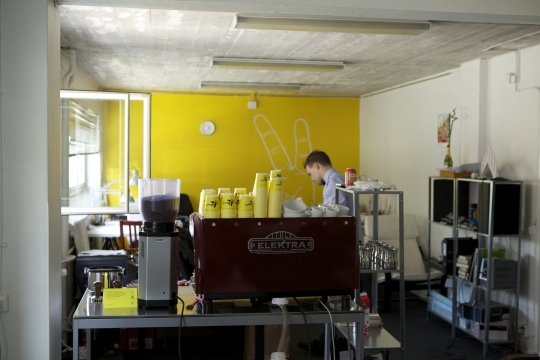
Serving coffee from the window of a co-working space on Hietalahdenkatu.
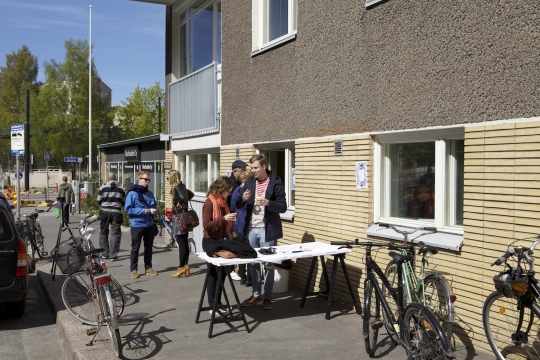
People waiting for their coffee.
As a tool for this we used iconic yellow Lippakioskis (in Finnish) (translates a "baseballcap kiosk", from the canopy) that are largely unused nowadays (many open for 3 months over summer, but only for basic fare, and remain unused at other times.) Designed in the 1930's and built during 1940's and 50's, there are now 19 kiosks standing around the city. Dan had made these blank A3's with a vector rendering of such a kiosk.
We ended up with almost 30 papers with some great ideas on them. Some people wanted to grow carrots and flowers on the roof of a kiosk, others to set up a summer lounge and use the kiosk as a DJ booth. There were a few especially noteworthy things. First, many of the papers had people socializing outside of kiosks. Could these kiosks act as community hubs for people to meet each others and socialize? The kiosks are dotted around the town mostly by the tram lines. These different districts have their own characteristics and atmosphere. How could Lippakioskis reflect those nuances of different parts of the city, just like they do in Käpylä and Kallio?
Besides the social aspect people would like to see more diverse offerings on the culinary side. Nowadays the kiosks serve, as mentioned ealier, just a basic fare - filter coffee, buns, soda and candy. Why nothing more interesting like espresso or home made doughnuts? Or why not organic local beer? What would you like to see, eat or drink in a Kioski?
As Dan already mentioned in his previous post, I just recently started here at the Strategic Design Unit as an intern. Currently I'm studying marketing at the University of Helsinki's Viikki campus. While telling people I'm a marketing student almost all of them reply "Marketing - at the Aalto University School of Economics, right?" The difference is that in Viikki we focus and specialize in understanding the marketing needs of the food industry and other players on the edible field whereas at Aalto it's purely marketing itself. I'm also doing a minor consisting of all kinds of food related subjects - a little bit of chemistry, logistics and so on.
The first weeks at Sitra has been very interesting and exciting - never before have I had a desk of my own and a view from the 14th floor, overseeing the beautiful seafront and archipelago of Helsinki and Espoo.
Being a barista, the first project I assigned to myself was to think of a better solution for the office coffee. Also, I've read at least a dozen articles and papers regarding the Helsinki Street Eats project.
Recently +Studio, a "design accelerator" and co-working space in the creative Punavuori district of Helsinki, held a breakfast session titled as the New Visions for Food. Futures specialist Ville Tikka, who also contributed to the Helsinki Street Eats book, from Wevolve agency presented his idea on how the food systems might change in the future. The linear value chain from farm to fork is likely (and already has in some cases) to transform into a network of functions interconnected to each other.
That concept will surely hover around the Street Eats project which is the one that I'll be working most with. We'll be taking a close look to street food in Helsinki and hopefully finding new ways to develop it. In addition to all things food related, I'll be helping out with Brickstarter as well as HDL 2012, as that shapes up.
During the first few weeks here at Sitra I've met so many interesting people. I'm very excited to start working with all these professionals and to really get my hands on the various projects at hand.
We are very excited to announce that the Design Exchange Programme is now seeking applicants for our second placement opportunity. This time the selected candidate will work in the Helsinki Department of Social Services for a year, helping to develop a culture of service design.
For more details, see the job posting.
The 'Exchange' project we've been referring to for a few months emerges a little, blinking in the shallow light of a cold December morning. We're looking for a strategic designer, with particular experience of urban and participatory design processes, to help design a new participatory design competition model for the development of the train station area in downtown Lahti.
It could be you! If you have a combination of excellent Finnish and some experience of architecture/urban planning, participatory processes and ideas competitions that is.
Bryan built a page at where you can find out more details and how to apply.
(This is a direct test of our notion that embedding a strategic design capacity at the heart of organisations makes the difference. It's a joint project with TEM, World Design Capital Helsinki, and City of Lahti, and hopefully the first of several similar experiments.)
Secondly, the City of Helsinki's Food Culture Strategy project manager, Ville Relander, dropped me a line about the former slaughterhouse building project he's been working on (an incredible space seen here back in June).
The first spaces in these premises are now becoming available for rent and Ville, and the City, are looking for "gastropreneurs" to apply - more info here. (The site's only in Finnish at the moment, so if you're not a Finnish speaker, get into Google Translate and see what you can do. Alternatively, get in touch with Ville directly - he'd be happy to answer any questions.)
Ville's showing people around the space tomorrow (Friday) 9th December at 1300 and again on Wednesday January 11th at 0900. Again, do get in touch with him directly to find out more (contact details at the bottom of this page or try Facebook, LinkedIn etc.).
First dusting of snow this week. Exciting!
From time to time we check in on other Sitra projects such as Low2No and today we're happy to announce something new.
Last November Helsinki edged out Eindhoven to win the status of World Design Capital for 2012. This is a big thing for our small city and it has spurred many conversations about what should, could, might, and hopefully will happen. Everyone here is anxious to have the world come see what design means to Helsinki.
We're especially happy to be helping Helsinki's World Design Capital foundation imagine new roles for design within the public sector and there will surely be more to talk about on that front as our collaboration evolves. But in the meantime...
To get our minds working we teamed up with OK Do for a quick project speculating on the hows that could enable the many good ideas already flowing around town. This became Clues for Open Helsinki: a pack of 17+1 postcards from the near future.
Each card features a nice idea (illustrated by Nene Tsuboi) and a set of speculative suggestions for how the city might use everything at its disposal to enable activity in this area.
We're interested in 2012 becoming the year that structural tools such as laws, taxes, permits, leases, financing, and metrics become part of the global design discourse. In other words, we'd like to see designers more actively involved in—and engaged—by strategic decisions and Clues to Open Helsinki is a small step in that direction.
It's always a little sad to come across a blog that has gone fallow. Sorry, world, but we hope to do a better job of posting regularly in the future.
In truth, it's hard for me to accept that it was five months ago that I was in Los Angeles giving the first sneak peak into what HDL 2010 will be. In the intervening months Marco and I have been spending a lot of time hashing out both the ambitions for HDL and seeking a reasonable way to see it through. Part of this process has been looking for examples of projects that are demonstrating the efficacy of strategic design tackling complex problems. Have any favorites? Leave us a comment below if you do!
While we've been quietly developing HDL, Sitra has been more visibly at work organizing Low2No: A Sustainable Development Competition centered around an urban block and HQ building in Jätkäsaari. With the centralization of Helsinki's ports to single new site, six separate logistical areas are being vacated. The competition site, Jätkäsaari, offers about a square kilometer of new land adjacent to central Helsinki for development. In other words, it's a fantastic opportunity that cities as established as Helsinki rarely find. But with this opportunity comes a challenge: to use existing models of development will ensure that our current out-of-balance lifestyle continues--massive resource consumption and carbon output. Can the design of one block be used as a catalyst to design and demonstrate new approaches to development that are not only sustainable but restorative and replicable?
From a competitive pool of 74 replies to our Request For Qualifications five teams were selected to develop proposals:
- ARUP – Sauerbruch Hutton – Experientia – Galley Eco Capital
- Bjarke Ingels Group, BIG – Vahanen – ARUP Foresight Innovation – Transsolar Energietechnik – Anttinen Oiva Arkkitehdit AoA – Masu Planning – Passiivitalo.fi – Pasi Mäenpää – Mikko Jalas
- Peter Rose & Partners – Michael Van Valkenburgh Associates – Guy Nordenson and Associates – Matthias Schuler, Transsolar Climate Engineering – Mobility in Chain – ARO Architectural Research Office
- REX/Croxton Collaborative/NOW – Transsolar Energietechnik – Magnusson Klemencic Associates – Bureau Bas Smets – 2x4 – Arup New York – Front – Jonathan Rose Companies
- WSP Group – Heatherwick Studios – B&M Architects – JK MM Architects – Space Syntax – Helsinki University – AA Palmberg Ltd – Pekka Himanen – Pauli Aalto-Setälä
By now the teams have completed their proposals and the winner will be announced on September 1st. If you live in Finland or happen to be in Helsinki on the first, please join us for the announcement cocktail hour and a chance to chat with the teams. You can find the practical details of the event here.
